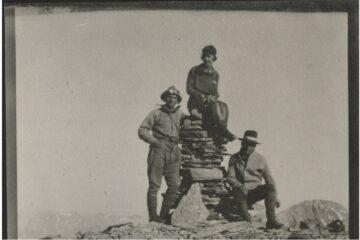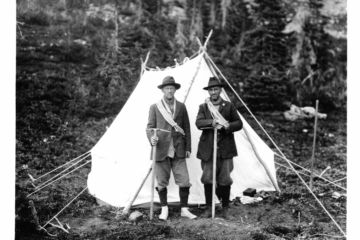It sometimes pays to be a pack rat! When I was asked to write something for the Edmonton Section’s centennial publication about my time with the ACC Environment Committee(s), I didn’t know where to start. However, upon digging through my old files, I realized that the ACC was really the start of my second career as a so-called “environmentalist.” I much prefer the term “steward,” as this implies keeping the land in “good heart,” while being able to benefit from its natural resources without destroying the very base on which we rely.
When I first came to Canada from Scotland in the early 1970s, I naturally gravitated to the mountains. And where better to learn about where and how to enjoy them than with the local ACC section? After a few years of exploration and experiences (good and bad), I became interested in some of the plans for our national and provincial parks, which were currently under development, so felt I could learn more by joining the ACC Environment Committee.
At that time – it was 1982 – Charlie Lockwood had just taken over the position of Edmonton Chair from Joey Jacks, and there were several issues on their plate. The committee had recently been renamed the ACC Mountain Management Committee, as “managing” our mountains and wildlands was becoming the major focus of the powers-that-be, as just leaving them alone for everyone to enjoy was no longer an option. There were many pressures on our public lands and parks from all sides—industry (oil/gas, coal, forestry) and recreation/tourism, not to mention general public use— so that some sort of more orderly development was becoming necessary.
The Four Mountain Parks Plan, which was supposed to define the future of Banff, Jasper, Yoho and Kootenay National Parks, had recently been circulated for public input, and we felt that the ACC should definitely make its voice heard considering the club’s long history with conservation issues in the mountain parks.1 The committee, therefore, circulated a questionnaire to all ACC members to gauge particular interest. We received over 650 responses! After wading through the pile of papers, we were able to make a concerted submission on behalf of the membership. It was noted that the “excellent Banff avalanche reports should be extended to all other areas.” One must look no further than the excellent work of the Canadian Avalanche Association, and its daily public avalanche bulletins, to see that there have been some improvements!
From then on, it was one parks plan and ski-area development after another, each requiring scrutiny and a response. Charlie left for points west in 1984, and so I took over as Chair, rather unwillingly, as I felt I didn’t have the knowledge and experience of other members. But I quickly had to learn! At the same time, we were trying to form better connections with the other ACC sections, as they also had similar problems, and we felt the more support we could give each other the better. The British Columbia sections, in particular, had many concerns, but were fortunate enough in 1985 to have the newly formed B.C. Wilderness Advisory Committee to advise on its many wilderness areas, such as Valhalla, Kokanee Glacier and Mt. Assiniboine Provincial parks.
At the time, a major concern for Alberta was its Policy for Resource Management of the Eastern Slopes (1984), which was supposed “to provide direction for watershed protection, resource development and activities, consistent with environmental protection.” (Does this sound a bit like the current Land Use Framework?). But this was only the beginning! Over the next few years, each major area had to develop its own Integrated Resource Management Plan (IRM). Thus, for example, the Bow Valley, Kananaskis, Nordegg-Red Deer, and Coal Branch IRMs were all individually scrutinized and commented upon, as these all had implications for the foothills regions outside the national parks.
In the meantime, other issues concerning recreation activities in the alpine areas were being addressed, such as mountain biking, heli-access, off-highway vehicles (OHVs), which enflamed debate. Our position was that certain activities, those which caused minimal damage or disturbance to the environment, were acceptable (e.g., rock climbing, but avoiding cliffs during eagle nesting season), but others were not compatible with conservation in alpine environments (in particular, OHVs , which are very intrusive and destructive of fragile landscapes – and aren’t supposed to be in Prime Protection (alpine) Zones anyway, at least according to the IRM plans). In addition, we tried to promote among members a set of commonsense conservation actions, like minimal-impact camping, leave-no-trace ethics, and respect for private and public property.
These were contentious issues in the late 1980s and early nineties. The Alberta Recreation and Parks Policy (1987) was killed in 1990 because of opposition to resource development in parks. Conversely, conservationists were buoyed by Federal Bill C-30, which, brought in by Jean Chretien’s Liberals, gave more protection for wilderness areas. The club was there through it all: Ted Code, for example, served as the ACC representative on the Public Advisory Committee to the Environment Council of Alberta.
Apart from these larger government initiatives, there were more than thirty specific proposals, all needing public input, too many to detail here. All of them required many letters, attendance at meetings, and articles written to try to spread the information and heighten awareness. There were a number of individuals who contributed to the work of the Committee. Graham Walker, in particular, was a most constant help.
All these multiplying activities were becoming too onerous for a small group of volunteers to adequately address, and so we were asked to produce a new Policy on Mountain Management, published in the 1988 ACC Gazette (in an unfortunately mixed-up format). In particular, much discussion was generated about the development of an advocacy role for the ACC, either as a “developer” of mountain huts or a “conservationist” opposing other developments in the mountain parks (like, for example, the continuing expansion of ski areas), while trying not to be accused of being “elitist” (wanting helicopter access for ourselves but not others, etc.).
As a result, Bruce Fairley was appointed to the ACC Executive as VP Environment in 1990 for national issues affecting the club and supporting more active participation of section committees on local issues. Thus, the Edmonton Section Environmental Committee (ESEC) was born, with Charles Truscott and Doreen Ronaghan as chairs over the next four years. Various federal and
provincial plans continued to keep them busy, like the Federal Green Plan, for instance, which aimed to increase protected land area nationally to twelve percent, as recommended by the Brundtland Report; this was followed by the Endangered Spaces campaign, to identify some of these particular areas. Particular drainages of concern included the Kakwa, Caw Ridge, Cline River, Bighorn, etc.
As the Coal Branch Sub-Regional IRP had identified the Tripoli Ridge area south of Hinton as a potential natural area worth protecting, it was suggested that the Edmonton Section could apply to Alberta Parks to become its stewards, as a proactive action for the section rather than the usual reactive response. We were officially recognized as its stewards in 1994, after the IRP had been accepted, thus ensuring that the Cardinal Divide Natural Area (CDNA), as it was now called, remained on the map of protected areas. Earlier, I had gotten my first taste of access management discussions, having visited the area a number of times to see what the problems were—mainly unrestricted OHV use, which was causing extensive damage in fragile alpine and subalpine areas. I again became chair of ESEC in 1994, and, from then on, the CDNA became a main focus for ESEC, particularly with the Environment Impact Assessment Hearings in 1997 for the new Cheviot Coal Mine, immediately adjacent to the CDNA. But this could be another whole article in itself!
We continued to provide input on other parks issues, such as Tonquin Valley management, Ski Area and Outlying Accommodation guidelines. But we still needed more guidance, as we felt the main club was becoming more focused on access rather than the environment. A new committee, the National Access and Environment Coordinating Committee (NAECC) was formed in 2001, with Winnipeg’s Peter Muir as Chairman. A new policy had been developed—although a survey of Edmonton Section members indicated that they had reservations about it; they felt there should be more emphasis on maintaining wilderness areas, even if it meant some restrictions. ESEC recommended the Federation of Mountain Clubs of B.C. policy reflected their position better and should be followed by the Section.
With the change in policies, and more of my time being absorbed by the new Whitehorse Wildland Park (formed as an extension of the CDNA, partly as a result of our presentations at the Mine hearings), I felt it was time to step down—nearly twenty years was quite long enough! Roderick Hazewinkel agreed to be the interim contact person for ESEC, and Terry McIntee and Lucy Scharfenberger would continue as the ACC Edmonton Section stewards of the CDNA/WWP for the time being. I continued as an individual steward of the area, as I was involved in several of its other aspects.
1: See Margaret Johnston and John Marsh, “The Alpine Club of Canada, Conservation and Parks, 1906 to 1930,” Canadian Alpine Journal 69 (1986): 25-29.


